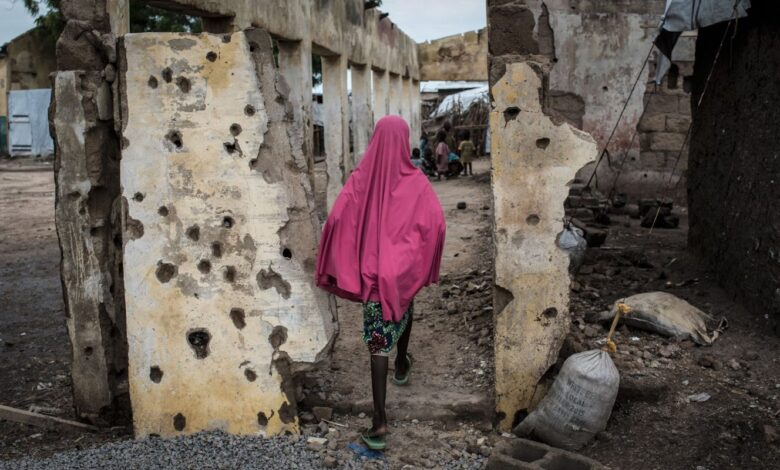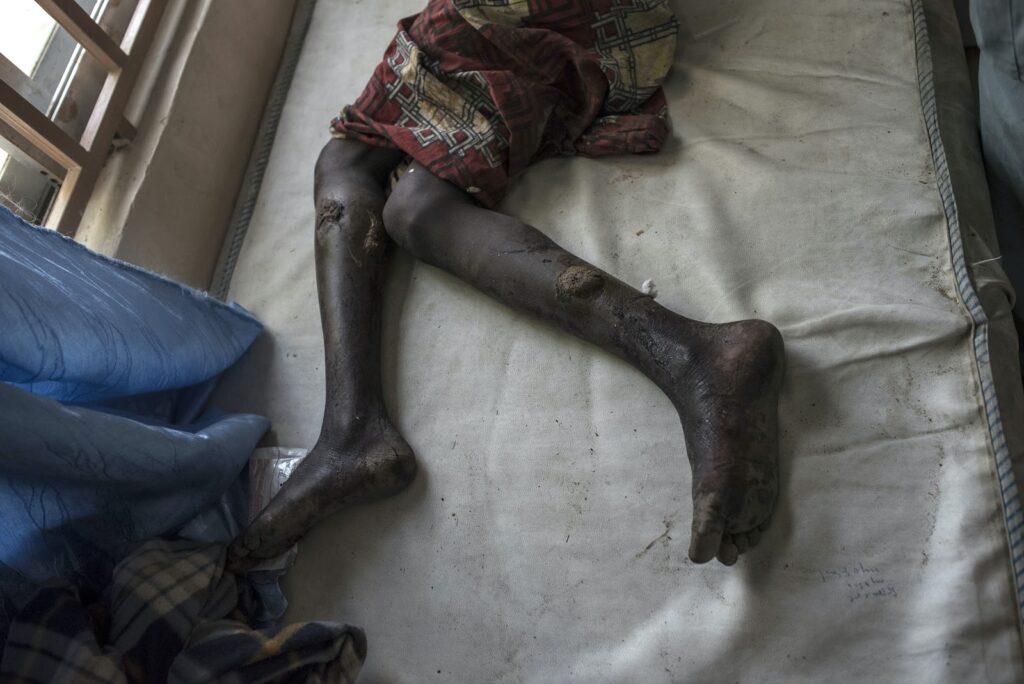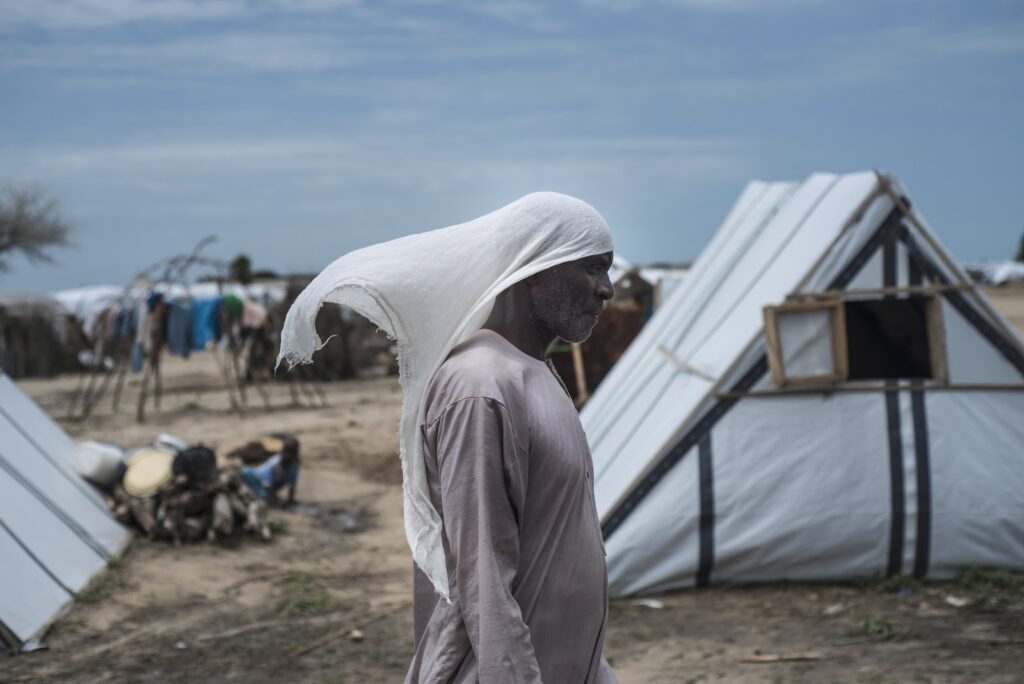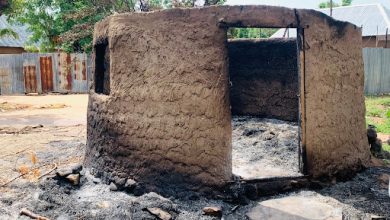U.S. Played Secret Role In Nigeria Attack That Killed More Than 160 Civilians
The 2017 bombing of a displaced persons’ camp was termed a “U.S.-Nigerian” operation, according to a document obtained by The Intercept.

The United States played an unacknowledged role in the 2017 bombing of an internally displaced persons’ camp in Nigeria that killed more than 160 civilians, many of them children.
A surveillance plane circled above the Rann IDP camp, which housed 43,000 people and was controlled by the Nigerian military, before a jet arrived and bombed the area where people draw water from a borehole, survivors of the attack said. The jet then circled and dropped another bomb on the tents of displaced civilians sheltering there.
The Nigerian air force expressed regret for carrying out the airstrike, which also killed nine aid workers and seriously wounded more than 120 people. But the attack was referred to as an instance of “U.S.-Nigerian operations” in a formerly secret U.S. military document obtained exclusively by The Intercept.
Evidence suggests that the U.S. launched a near unprecedented internal investigation of the attack because it secretly provided intelligence or other support to the Nigerian armed forces, a contribution hinted at by Nigerian military officials at the time. The U.S. inquiry, the existence of which has not been previously reported, was ordered by the top American general overseeing troops in Africa and was specifically designed to avoid questions of wrongdoing or recommendations for disciplinary action, according to the document.
Conducted as part of a long-running counterinsurgency campaign against the terrorist group Boko Haram, the Jan. 17, 2017, attack on the camp, located in Rann, Nigeria, near the Cameroonian and Chadian borders, also destroyed at least 35 structures, including shelters for war victims who had been forced from their homes.
The Nigerian Air Force bombed the internally displaced persons’ camp — which had been set up by the Nigerian military — because “the location was not reflected in the operational map as a humanitarian base,” according to Maj. Gen. John Enenche, Nigeria’s director of defence information. “Hence, it appeared as a place that could equally be used for enemy activities.”
Nigerian human rights activists questioned how the military could be unaware of the camp and alleged a cover-up. The tents were visible from the air, according to satellite imagery. Last year, Agnès Callamard — then-United Nations special rapporteur on extrajudicial, summary, or arbitrary executions — noted the absurdity of the strike. “The military presence in Rann, its role in establishing the camp and their facilitation of the humanitarian distribution on the day, raise many questions,” she wrote in a 2021 report. “No independent investigation was carried out.”
Just days after the attack, U.S. Africa Command secretly commissioned Brig. Gen. Frank J. Stokes to undertake an “investigation to determine the facts and circumstances of a kinetic air strike (‘strike’) conducted by Nigerian military forces in the vicinity of Rann, Nigeria.” Its findings were never made public.
AFRICOM did not answer The Intercept’s questions about the results of Stokes’s investigation or the extent of U.S. involvement in the attack.
“Civilian victims, and the American and Nigerian publics, deserve answers about any U.S. role in this devastating strike” said Annie Shiel, senior adviser for the United States at the Center for Civilians in Conflict, or CIVIC. “What exactly was the United States’s involvement? What were the findings of the investigation — including findings of wrongdoing — and what kind of responsibility does the U.S. acknowledge for the grave harm caused?”

The formerly secret document directed Stokes — deputy director of AFRICOM’s directorate for strategy, engagements, and programs — to be “sensitive” regarding the assessment of materials “maintained within special access programs,” often referred to as SAPs. Sometimes called “black programs,” SAPs are highly classified with strictly enforced security measures and need-to-know access requirements. Certain SAPs are unacknowledged: their funding hidden within the federal budget and their existence formally denied.
Spokesperson Kelly Cahalan said that AFRICOM “was not involved” in the bombing of the Rann IDP camp, but secret and low-profile programs on the African continent can be carried out by the CIA or Special Operations forces under their own chains of command. While AFRICOM takes responsibility for drone strikes, for example, they are generally carried out by a Joint Special Operations Command, or JSOC, task force.
Retired Brig. Gen. Donald Bolduc, chief of Special Operations Command Africa at the time of the Rann strike, told The Intercept in 2018 that although JSOC was required to coordinate and deconflict through his headquarters, that didn’t always happen. “I get a phone call and someone will say, ‘What are you doing in that area when we weren’t aware you were there?’ and I’ll say, ‘I wasn’t in that area, so I don’t know,’” Bolduc said at the time. “Later, you come to find out it was a JSOC element doing something. That undermines trust. It’s not a good thing.”
U.S. surveillance and intelligence-gathering operations have often been employed near Nigeria, including a Predator drone flown from neighbouring Chad, in addition to a longer-range Global Hawk and a manned, turbo prop plane, deployed over Nigeria beginning in 2014, ostensibly to search for children kidnapped by Boko Haram.
In neighbouring Niger, the U.S. flew drones from bases in Dirkou and Niamey. In 2016, The Intercept reported on a secretive drone base in Garoua, Cameroon, near the Nigerian border, employing drones which could carry out 24-hour surveillance, allowing “U.S. intelligence analysts to gather detailed information about Boko Haram’s movements, bomb-making factories, and military camps.” Also mentioned were British, French, and U.S. intelligence units — based in Abuja, Nigeria; Maroua, Cameroon; and N’Djamena, Chad — serving as “clearinghouses for intelligence about Boko Haram.”
That same year, the process by which the U.S. provided information — like aerial surveillance photos — to aid Nigeria’s fight against Boko Haram was streamlined from as many as two weeks to one hour, the New York Times reported, specifically noting that “drone photos” were provided to the Nigerian army. In 2017, The Intercept also revealed the existence of a drone base and torture centre used by U.S. contractors in Salak, Cameroon, in the northern border region between Nigeria and Chad.
Cahalan, the spokesperson, insisted that AFRICOM had no “additional information” on the Rann airstrike but did not respond to a question of how this was possible given that then-AFRICOM commander, Gen. Thomas D. Waldhauser, had ordered a top AFRICOM officer to conduct a formal investigation that included “gathering accounts of the strike or information … from witnesses,” inspecting documents, and collecting “information which will support any subsequent reviews of the strike … and shape the manner in which any future coalition or partner nation operations are conducted.”
Redactions to the document, obtained under the Freedom of Information Act, make it impossible to ascertain the full extent of U.S. involvement in the 2017 airstrike, but Stokes’s official instructions suggest that the U.S. provided intelligence or other support to the Nigerian military. “You will gather and preserve any background information that is relevant to a complete understanding of U.S.-Nigerian operations such as this strike,” reads the document. Stokes’s mandate included an inquiry into how the U.S. shares information with Nigeria’s military, protocols concerning its use, and “after action reporting procedures when shared information is used in a strike (e.g., battle damage assessment reports).”
The formal investigation of an African partner’s airstrike was rare, if not unprecedented, and indicates this was no ordinary Nigerian bombing gone wrong. A former Pentagon official with expertise in investigations of civilian casualty incidents, who spoke to The Intercept on the condition of anonymity, said that he had never encountered a U.S. investigation of an ally’s airstrike.
In a 2017 special investigative project for Nigeria’s The Cable — a news outlet supported by the MacArthur Foundation — journalist Mayowa Tijani reported that the regional military commander, Gen. Lucky Irabor (now Nigeria’s defence chief), “admitted that he ordered the attacks in Rann, based on intelligence received.” While Irabor did not disclose the source of the intelligence, Tijani wrote that a “senior military source” suggested it had originated with “one of the powerful countries in the west.”
“It’s vitally important that the U.S. acknowledge and reckon with civilian harm caused in partnered operations,” Brian Finucane, a senior adviser at the International Crisis Group and former legal adviser to the State Department, told The Intercept. “If U.S. forces were partnered with Nigerian forces or provided concrete operational support, they could have reason to be concerned about this strike.”
Earlier this year, The Intercept revealed how U.S. targeting assessments carried out for another allied military led to a 2015 airstrike on an ISIS bomb factory in Hawija, Iraq, that touched off secondary explosions, killing at least 85 civilians. In the wake of that Dutch airstrike, the chief of targets for U.S. Central Command insisted that the attack had been conducted by the book, including the pre-strike “collateral damage estimate,” or CDE. “This was a perfectly accurate CDE call,” he insisted, emphasising that “CDE Methodology does not account for secondary explosions.”
No Americans were held accountable for the civilian deaths in the Hawija strike, in keeping with a litany of attacks from Somalia to Libya and from Syria to Yemen that the Pentagon has failed to investigate or reinvestigate despite civilian casualty allegations. Earlier this year, Rep. Sara Jacobs, D-Calif., asked whether the Defense Department was planning to revisit civilian harm allegations for cases in which new evidence has come to light.
“At this point,” Secretary of Defense Lloyd Austin replied, “we don’t have an intent to re-litigate cases.” (Austin is soon expected to sign a long-awaited Memorandum on Improving Civilian Harm Mitigation and Response which he ordered in the wake of civilian casualty scandals that buffeted the Pentagon last year.)
Regarding the Nigerian attack on the IDP camp, Stokes was instructed not to focus “on any person or organisation which took part in this strike” nor to “make recommendations as to any disciplinary actions to be taken.” He was also officially handcuffed in terms of accountability. “You do not have any authority to compel potentially incriminating evidence from any Service member, civilian employee of the U.S., contractor personnel supporting U.S. operations, or foreign military personnel,” reads his mandate.

Prior to the airstrike on the Rann camp, during the Obama administration, the U.S. prevented Nigeria from buying attack aircraft due to concerns about the country’s human rights record. Less than a month after the bombing — and five days after Stokes was to have submitted his findings — President Donald Trump spoke with Nigerian President Muhammadu Buhari and “expressed support for the sale of aircraft from the United States to support Nigeria’s fight against Boko Haram,” according to a White House readout of the telephone call.
Later that year, the U.S. agreed to sell Nigeria 12 Super Tucano warplanes, including thousands of bombs and rockets, for $593 million, then the largest U.S. foreign military sale in sub-Saharan Africa. “These new aircraft will improve Nigeria’s ability to target terrorists and protect civilians,” Trump said during a 2018 White House meeting with Buhari.
“The timeline is striking,” Lauren Woods, director of the Security Assistance Monitor at the Center for International Policy, told The Intercept. “The strike on the IDP camp happened in Jan. 2017, and already by August of the same year, the U.S. government had approved the sale of more aircraft — the Super Tucano aircraft and weapons — to the Nigerian government.”
Neither the weapons sales nor the killing of civilians were Trump-era anomalies. In April 2021, a Nigerian military helicopter reportedly launched indiscriminate attacks on homes, farms, and a school in an effort to strike at “bandits.” Last September, following an initial denial, the Nigerian Air Force admitted that it attacked a village in Yobe State, killing 10 civilians and injuring another 20. But this spring, the U.S. approved a possible $1 billion sale of 12 attack helicopters and related training and equipment to Nigeria.
“As the U.S. continues to deepen its security assistance to Nigeria, including through recent weapons sales, we also need far more transparency about what steps have been taken to prevent and respond to civilian harm using U.S. assistance,” said CIVIC’s Shiel. “So far, the U.S. government hasn’t provided satisfying answers. Congress should demand these answers publicly.”
This February, a Nigerian Air Force attack on more “bandits” just over the border in Niger reportedly killed 12 civilians, seven of them children. Earlier this month, the Nigerian Air Force also bombed civilians in Kakuna village, killing at least one person and injuring 13 others.
“The tragic Rann event, and more contemporary air strikes, underscore the need for the Nigerian armed forces to improve their targeting and air-ground coordination for air strikes to prevent civilian casualties,” said Will Meeker, Africa director at CIVIC. “CIVIC encourages the armed forces to adopt practices to mitigate, track, and respond to civilian harm, including by providing amends to the victims and their families.”
Despite a 20-year security partnership, during which the U.S. has armed and trained Nigerian troops, the West African country’s security forces have failed to defeat Boko Haram, which they’ve been fighting since 2009; an Islamic State affiliate; and various militarised “bandit” groups. The Nigerian military has also routinely committed grave human rights abuses, according to a report issued earlier this year by Brown University’s Center for Human Rights and Humanitarian Studies, the Security Assistance Monitor at the Center for International Policy, and InterAction.
“Nigeria has faced multiple setbacks in the last year, as ISIS-West Africa continues to confront security forces, seize materiel — including armoured vehicles, weapons, and ammunition — and expand its operational reach,” incoming AFRICOM Commander Lt. Gen. Michael Langley recently told the Senate Armed Services Committee. “This has strained the Nigerian military’s readiness and capabilities.” Around 350,000 civilians have died as a result of the conflict in northeastern Nigeria.
Ryan Essman, deputy spokesperson at the State Department’s Bureau of African Affairs, said the U.S. “routinely engages with the Armed Forces of Nigeria to actively reinforce civilian protection and human rights practices through our security force professionalisation efforts that seek to create a modern and effective force.” But the State Department’s most recent human rights assessment found credible reports of unlawful and arbitrary killings, forced disappearances, and cruel, inhuman, or degrading treatment or punishment, among many other crimes, by the Nigerian government.
Essman also insisted that the U.S. “was not involved” in the 2017 Rann bombing.

Exactly how many people were killed in the bombing remains unknown. Callamard, the U.N. special rapporteur, was provided a list with the names of 127 victims, two-thirds of them children. Witnesses involved in the burial say 167 victims were interred in Rann cemetery, while a local government official put the number at 236 dead.
Witnesses described finding large numbers of ball bearings following the bombing. Photos of the dead and wounded, according to Callamard’s report, also “showed both massive and smaller wounds, consistent with firing of ball bearings-based ammunitions.” The allegations that such munitions were used are “extremely serious,” Callamard noted, and “should have been independently investigated.”
Experts say the U.S. government needs to come clean about its involvement in the Rann airstrike — and other similar instances around the world that the U.S. may be keeping secret.
“I think this example raises the question of, when the U.S. provides weapons and equipment that can be used for attacks, and when it provides intelligence that inform those attacks, what responsibilities should it have to make sure those capabilities and that information is used responsibly and carefully?” the former Pentagon official told The Intercept. “The U.S. provides more arms internationally than anyone and we provide training and advising on their use, but we still provide very little advisory support or capabilities to help partners to avoid harm to civilians.”
By Nick Turse. Originally published on July 28, 2022. Republished with permission from The Intercept, an award-winning nonprofit news organisation dedicated to holding the powerful accountable through fearless, adversarial journalism. Sign up for The Intercept’s Newsletter.
Support Our Journalism
There are millions of ordinary people affected by conflict in Africa whose stories are missing in the mainstream media. HumAngle is determined to tell those challenging and under-reported stories, hoping that the people impacted by these conflicts will find the safety and security they deserve.
To ensure that we continue to provide public service coverage, we have a small favour to ask you. We want you to be part of our journalistic endeavour by contributing a token to us.
Your donation will further promote a robust, free, and independent media.
Donate HereStay Closer To The Stories That Matter




